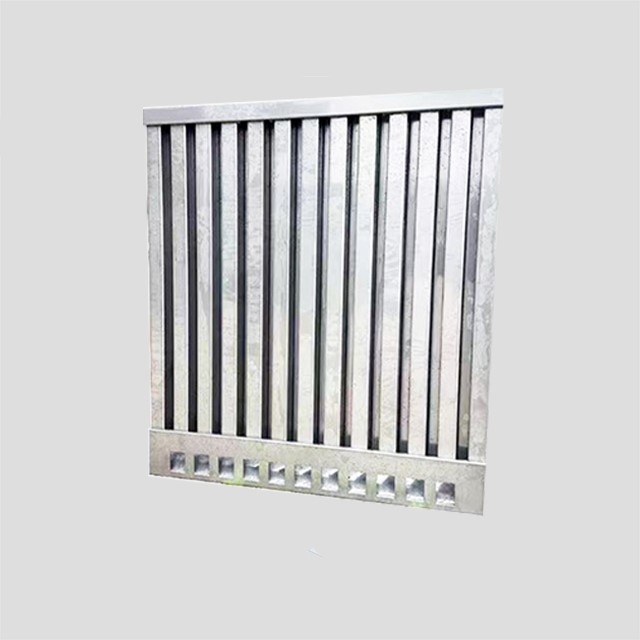Vanman Sand Louver — Two-Stage Sand & Rain Separation with High Free Area
Vanman sand louvers are façade/air-inlet devices engineered for dusty and desert climates. Through a structural two-stage labyrinth, they intercept wind-driven sand and rain in successive chambers; separated particles drop by gravity and discharge through openings on an inclined bottom plate to the exterior. The airflow path is shaped to preserve ventilation efficiency while trapping coarse contaminants.

Sand Louver
How It Works
• Stage 1: Incoming wind carries sand/rain into the first chamber; geometry blocks large particles and droplets.
• Stage 2: Remaining fines follow a curved path into the second chamber, where inertia and geometry intercept more particles; trapped sand/rain falls and is expelled via bottom openings on the sloped base.
Result: effective sand/rain separation while maintaining high ventilation efficiency and free area (document note).
Key Benefits
• Two barriers against sand — “Hui” layout with a double sand-defense structure to reduce
ingress in dusty environments.
• High free area — Category designed for a larger free area vs. typical peers, helping to limit
system pressure loss.
• Acoustic option without area penalty — Silencer modules can be connected on the inside
without changing free area.
• Robust & secure — Sample configuration shown in 316 stainless steel, 2 mm thick for strong
impact resistance; blade bolt connections provide anti-tamper security and stability against
hurricane-level winds (no shaking or deformation).
• Visual screening — Blade geometry blocks line-of-sight for privacy and architectural
concealment of equipment.
Construction & Materials
• Materials: aluminum, stainless steel, carbon steel, galvanized steel, Al-Mg-Zn coated
steel. Finishes include powder coating, PVDF (fluorocarbon), anodizing.
• Blade/frame: blades bolted to the frame for rigidity and security; assembly tested to resist
hurricane effects (design note).
• Drainage: inclined base with exterior discharge openings to evacuate collected sand and
rain.
Options & Accessories
• Bird mesh / insect mesh
• Flange interface
• Pre-filter (where specified by HVAC design)
• Silencer (inline, no free-area change)
• Safety guard / anti-fall grille
• Actuation & hinges (for access/closure or motorized variants)
Motorized option: When specified as a motorized sand louver, Vanman’s control cabinet supports 100–240 VAC input, 24 V output (10–80 A), multi-channel/cascade control, sensor inputs (smoke/rain/wind/temperature/humidity/gas), and a 24 V backup battery; linear actuators 500–2000 N, IP32, endurance 10,000 double strokes, and fire test per DIN 18232-3 (as specified).
Typical Applications
• Desert & dusty climates — building fresh-air intakes for AHUs, plant rooms, substations.
• Industrial & logistics buildings — pre-separation of coarse dust/sand to extend downstream
filter life (with project-specific filters).
• Public & commercial facilities — where visual screening and weather protection are required
at air inlets.
FAQ
Q: How is a sand louver different from a standard weather louver?
A: A sand louver uses a two-stage, labyrinth path that forces the airstream to change direction, letting sand and rain fall out by gravity before air enters the duct/room. Standard weather louvers emphasize rain rejection without the dual sand-separation chambers.
Q: Does the sand louver replace filters?
A: No. It pre-separates coarse sand/dust to protect downstream equipment and filters. Where filtration is required, specify the appropriate pre-filter and HVAC filter bank.
Q: Will adding a silencer reduce the free area?
A: Vanman’s design allows an inline silencer on the interior side without changing free area (per document), preserving airflow capacity.
Q: Can it be motorized or provide maintenance access?
A: Yes. Actuation and hinges are available as options; motorized configurations can integrate with BMS, sensors, and 24 V backup per Vanman’s control platform.
Design & Coordination Notes (for MEP/Architects)
• Provide access for periodic clean-out of the discharge zone; hinges/actuation facilitate
maintenance.
• Coordinate mesh, flange, and pre-filter selections with the HVAC filtration strategy.
• For acoustics, specify silencers aligned with the flow path to retain free area.
• Vanman can supply submittals with sections, interface details, and (upon request) pressure-
loss/selection support for the project.
Internal Linking (Recommended)
• Need automatic opening/closing or BMS integration? See Vanman ESL200 Motorized
Louver (thermally-broken insulated blades).
• For roof natural ventilation/smoke relief with operable louvers: Vanman Pro Series.
• For storm-resistant horizontal roof louvers: Vanman Aeolus Series.
• For façade daylighting + ventilation: Vanman Glass Louver category.
